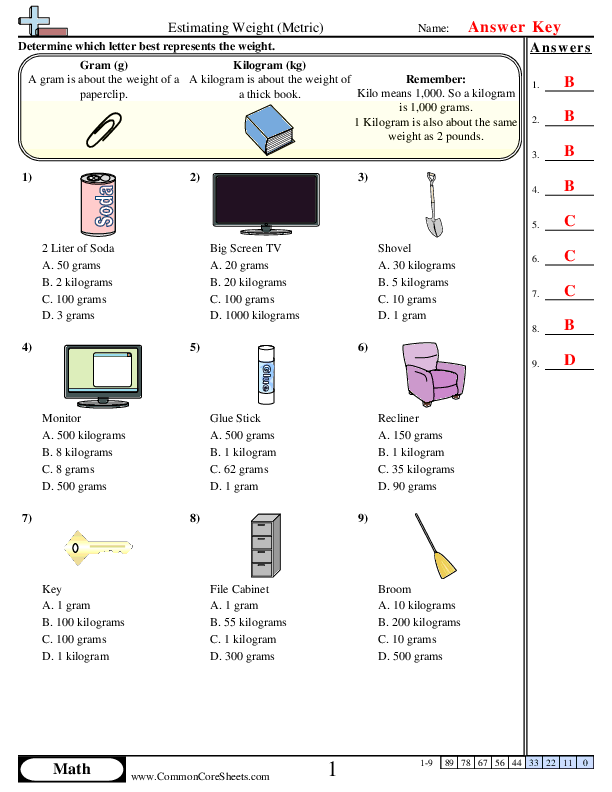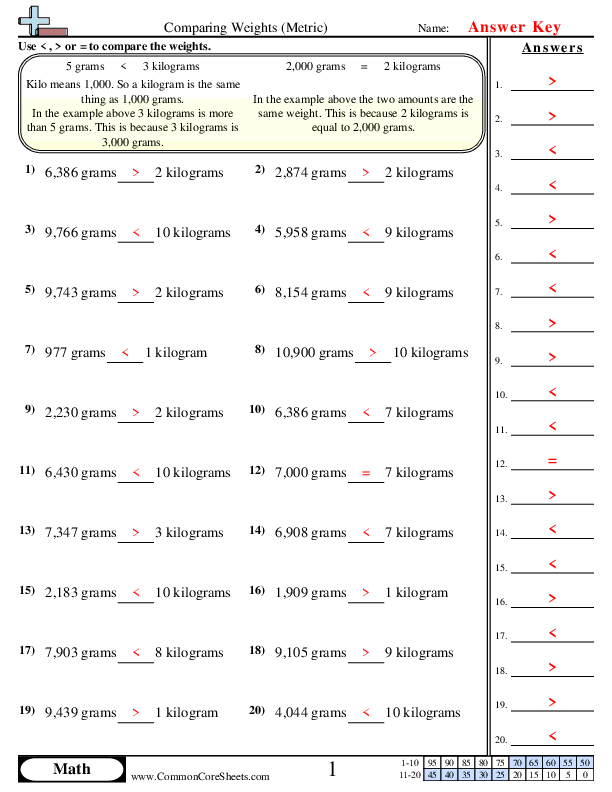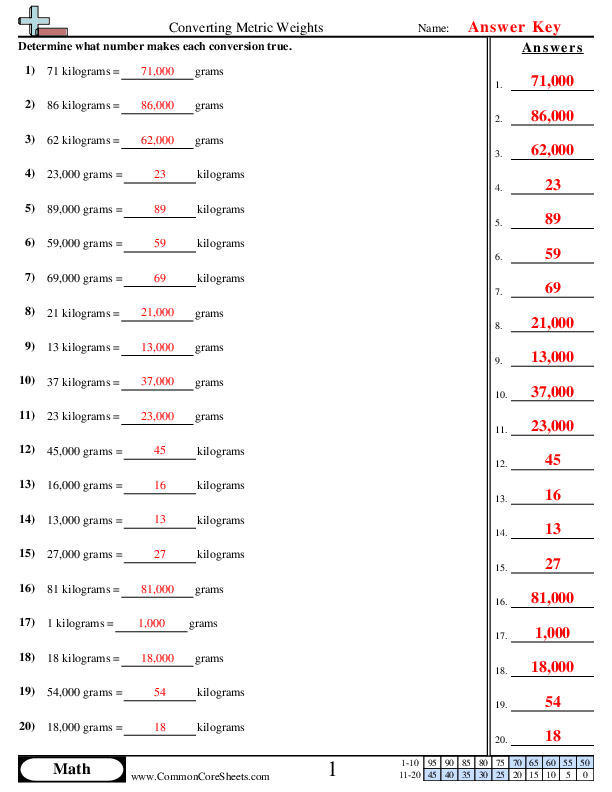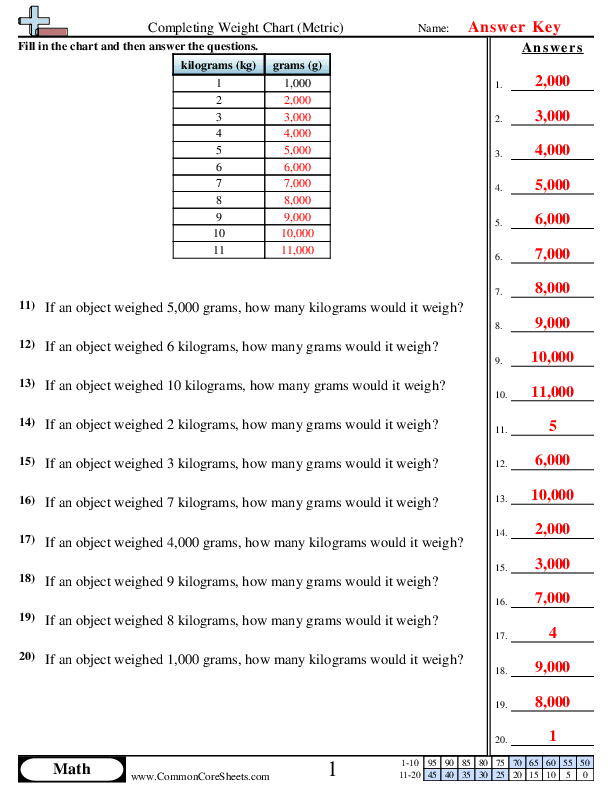Looking for the best weight worksheets on the internet? Look no further! Our free weight worksheets are ideal for reading a scale, estimating weight, and understanding both American and metric measurements. With our weight worksheets, you can easily practice and perfect measurements of any kind. From ounces to pounds to kilograms, our weight worksheets will help you understand how to accurately measure various weights. Perfect your skills with our printable weight worksheets today!
Browse Sheets By Problem Type
×

Estimating Weight
3md2


×
Description:
"This worksheet is designed to enhance children's understanding of the metric weight system. It includes nine math problems asking students to estimate the weight of common objects, making abstract concepts tangible. Content, flexible in nature, can be customized to suit individual learner's needs, converted into flashcards for interactive learning, or incorporated into distance learning curricula. An effective tool bridging the gap between classroom concepts and real-world applications."

×
Student Goals:
Understanding Measurement UnitsUpon completion of this worksheet, students should be able to recognize and understand the use of different units of measurement in the metric system, specifically grams and kilograms. This foundational knowledge is critical in their mathematical journey, as the metric system is extensively used across various fields such as science, engineering and everyday life.Estimation SkillsStudents will have developed their estimation skills — an important mental math tool allowing them to make swift, reasonable approximations on the weight of different common objects. This can be useful in numerous real-world scenarios, helping them to make quick decisions or judgments when precise measurements are not necessary or available.Problem-solvingWith practice from the worksheet, students will have sharpened their problem-solving abilities. This skill is not only crucial in mathematical assignments and tests, but also in day-to-day tasks and challenging situations. By carefully examining, analyzing the options and making a calculated decision, students learn how to respond to different problems effectively.Knowledge ApplicationCompletion of the worksheet will mean the students have effectively applied their knowledge of metric units in a practical, real-world context. This application of theoretical learning will enhance the students' understanding of metric units and how they are used to estimate weights of everyday objects.Critical ThinkingThrough this worksheet, students will improve their critical thinking skills by choosing the most plausible answer from several options. By comparing and contrasting different options, they improve their ability to think logically and rationally, skills that are necessary across many disciplines.Concept ReinforcementCompleting this worksheet will reinforce the students' understanding of metric weights in terms of grams and kilograms, and assist in solidifying their understanding of the distinction between these units. This is paramount in ensuring students do not confuse these units in future mathematical applications.



Comparing Weights
4md1


×
Description:
"This worksheet is designed to enhance children's understanding of metric weights. It includes 20 math problems that encourage students to compare and contrast different measurements in grams and kilograms. Its adaptable format allows it to be customized to individual learning needs, converted into flashcards, or utilized effectively in distance learning. A valuable tool for building crucial math skills in a fun and engaging way."

×
Student Goals:
Understanding Metric WeightsAfter completing this worksheet, students should have a solid understanding of metric weights, primarily grams and kilograms. They should be capable of converting from grams to kilograms and vice versa, understanding the relationship between these two units of measurement. They should recognize that 1 kilogram equals 1,000 grams.Comparison SkillsStudents should develop strong comparison skills. The ability to compare and evaluate different metric weights is crucial in many mathematical and real-world scenarios. They should be able to analyze and compare the weights of different objects, determine which is heavier or lighter, and make logical conclusions based on their comparisons.Mental ArithmeticThis worksheet should enhance students' mental arithmetic skills, particularly in relation to measurement units. They will need to convert between units and compare different quantities, improving their ability to perform calculations in their head. This skill is essential for quick decision-making and problem-solving in everyday situations.Problem-Solving SkillsWorking through the problems should improve students' problem-solving abilities. As they navigate the metric system and solve comparison puzzles, they learn to approach problems from different angles and devise various strategies for resolution. This experience will boost their confidence in confronting and resolving future mathematical problems, laying a solid foundation for more complex problems.Knowledge ApplicationsStudents should be able to apply the knowledge gained from this worksheet in various practical situations. Understanding weights and measures is fundamental in many everyday tasks, such as cooking, shopping, or estimating weight or size of objects. The acquired skills will allow students to make practical estimations and decisions, enhancing their credibility in real-world applications.Conceptual UnderstandingFinally, students completing this worksheet should gain a deep conceptual understanding of the metric system, rather than just rote memorization of facts. This deeper level of understanding will enable them to apply their learning in new contexts and assist in the recall of information, thereby enhancing their long-term learning achievements.



Converting Metric Weights


×
Description:
"This worksheet is designed to reinforce concepts in mathematics, specifically focusing on the conversion of metric weights. It contains 20 problems that help children understand how grams and kilograms relate. The customizable format of the worksheet also allows it to be adapted into flashcards or used in a distance learning context, offering flexible options for various learning environments and tutoring needs."

×
Student Goals:
Understanding Metric WeightsUpon completion of the worksheet, the student should have a comprehensive understanding of metric weights, specifically the relationship between kilograms and grams.Conversion ProficiencyThe students should be able to confidently convert metric weights from grams to kilograms and vice versa without errors. This proficiency is not only necessary for math problems but will help students in everyday situations, such as understanding weights listed in grams or kilograms, ensuring stronger practical application skills.Enhanced Mathematical SkillsThe worksheet problems will also aid in improving the students' mathematical skills. They will learn to make quick calculations, boosting their mental arithmetic abilities and honing their attention to details. They would be able to accurately compute and decipher large numbers, which will boost their overall math acumen.Critical Thinking and Problem SolvingBy working through these conversion problems, students will develop their critical thinking and problem-solving skills. This includes figuring out how to approach each conversion, identifying patterns, and making logical deductions, as part of the process.Confidence in Handling Metric SystemAfter completing the worksheet, students should feel more confident in handling, navigating, and understanding the metric system in general. This experience would leave them better equipped to interact with similar mathematical problems and systems in the future.Independence in LearningThis worksheet is designed to encourage students to work independently. By the end of the challenge, students should feel more comfortable with their ability to learn and understand new ideas on their own. This fosters an enthusiasm for independent learning and a higher level of self-confidence in their educational journey.





